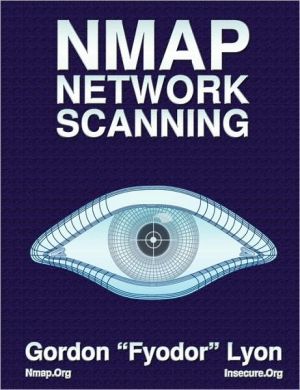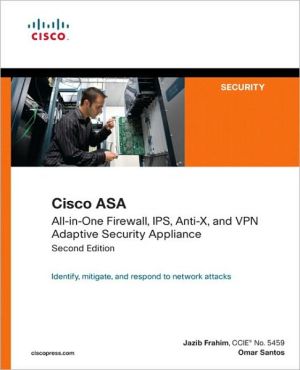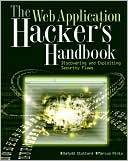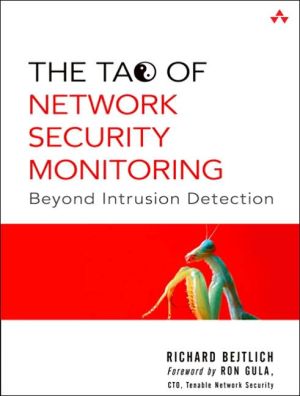Crimeware: Understanding New Attacks and Defenses
“This book is the most current and comprehensive analysis of the state of Internet security threats right now. The review of current issues and predictions about problems years away are critical for truly understanding crimeware. Every concerned person should have a copy and use it for reference.”\ —Garth Bruen, Project KnujOn Designer\ There’s a new breed of online predators—serious criminals intent on stealing big bucks and top-secret information—and their weapons of choice are a dangerous...
Search in google:
“This book is the most current and comprehensive analysis of the state of Internet security threats right now. The review of current issues and predictions about problems years away are critical for truly understanding crimeware. Every concerned person should have a copy and use it for reference.”—Garth Bruen, Project KnujOn DesignerThere’s a new breed of online predators—serious criminals intent on stealing big bucks and top-secret information—and their weapons of choice are a dangerous array of tools called “crimeware.” With an ever-growing number of companies, organizations, and individuals turning to the Internet to get things done, there’s an urgent need to understand and prevent these online threats.Crimeware: Understanding New Attacks and Defenses will help security professionals, technical managers, students, and researchers understand and prevent specific crimeware threats. This book guides you through the essential security principles, techniques, and countermeasures to keep you one step ahead of the criminals, regardless of evolving technology and tactics. Security experts Markus Jakobsson and Zulfikar Ramzan have brought together chapter contributors who are among the best and the brightest in the security industry. Together, they will help you understand how crimeware works, how to identify it, and how to prevent future attacks before your company’s valuable information falls into the wrong hands. In self-contained chapters that go into varying degrees of depth, the book provides a thorough overview of crimeware, including not only concepts prevalent in the wild, but also ideas that so far have only been seen inside the laboratory.With this book, you will Understand current and emerging security threats including rootkits, bot networks, spyware, adware, and click fraud Recognize the interaction between various crimeware threats Gain awareness of the social, political, and legal implications of these threats Learn valuable countermeasures to stop crimeware in its tracks, now and in the future Acquire insight into future security trends and threats, and create an effective defense planWith contributions by Gary McGraw, Andrew Tanenbaum, Dave Cole, Oliver Friedrichs, Peter Ferrie, and others.
Traditionally, malware has been thought of as a purely technical threat, relying principally on technical vulnerabilities for infection. Its authors were motivated by intellectual curiosity and, sometimes, by competition with other malware authors.\ This book draws attention to the fact that this is all history. Infection vectors of today take advantage of social context, employ deceit, and may use data-mining techniques to tailor attacks to the intended victims. Their goal is profit or political power. Malware has become crimeware. That is, malware has moved out of basements and college dorms, and is now a tool firmly placed in the hands of organized crime, terror organizations, and aggressive governments. This transformation comes at a time when society increasingly has come to depend on the Internet for its structure and stability, and it raises a worrisome question: What will happen next? This book tries to answer that question by a careful exposition of what crimeware is, how it behaves, and what trends are evident.\ The book is written for readers from a wide array of backgrounds. Most sections and chapters start out describing a given angle from a bird’s-eye view, using language that makes the subject approachable to readers without deep technical knowledge. The chapters and sections then delve into more detail, often concluding with a degree of technical detail that may be of interest only to security researchers. It is up to you to decide when you understand enough of a given issue and are ready to turn to another chapter.\ Recognizing that today’s professionals are often pressed for time, this book is written so that each chapter is relatively self-contained. Rather than having each chapter be sequentially dependent on preceding chapters, you can safely peruse a specific chapter of interest and skip back and forth as desired. Each chapter was contributed by a different set of authors, each of whom provides a different voice and unique perspective on the issue of crimeware.\ This book is meant for anyone with an interest in crimeware, computer security, and eventually, the survivability of the Internet. It is not meant only for people with a technical background. Rather, it is also appropriate for makers of laws and policies, user interface designers, and companies concerned with user education. The book is not intended as a guide to securing one’s system, but rather as a guide to determining what the problem really is and what it will become.\ Although we often use recent examples of attacks to highlight and explain issues of interest, focus here is on the underlying trends, principles, and techniques. When the next wave of attacks appears—undoubtedly using new technical vulnerabilities and new psychological twists—then the same principles will still hold. Thus, this book is meant to remain a useful reference for years to come, in a field characterized by change. We are proud to say that we think we have achieved this contradictory balance, and we hope that you will agree.
Preface xviiAbout the Authors xxiChapter 1: Overview of Crimeware 11.1 Introduction 21.2 Prevalence of Crimeware 41.3 Crimeware Threat Model and Taxonomy 51.4 A Crimeware Menagerie 81.5 Crimeware Distribution 191.6 Infection and Compromise Points, Chokepoints, and Countermeasures 251.7 Crimeware Installation 291.8 Crimeware Usage 311.9 Organizing Principles for the Remainder of This Text 35Chapter 2: A Taxonomy of Coding Errors 372.1 The Trinity of Trouble 382.2 The Seven Pernicious Kingdoms 402.3 The Phyla 462.4 More Phyla Needed 52Chapter 3: Crimeware and Peer-to-Peer Networks 553.1 Malware in Peer-to-Peer Networks 553.2 Human-Propagated Crimeware 76Chapter 4: Crimeware in Small Devices 834.1 Propagation Through USB Drives 834.2 Radio Frequency ID Crimeware 894.3 Mobile Crimeware 99Chapter 5: Crimeware in Firmware 1035.1 Propagation by Firmware Updates 1035.2 Modeling WiFi Malware Epidemics 130Chapter 6: Crimeware in the Browser 1556.1 Transaction Generators: Rootkits for the Web 1556.2 Drive-By Pharming 1606.3 Using JavaScript to Commit Click Fraud 167Chapter 7: Bot Networks 1837.1 Introduction 1837.2 Network-Oriented Features of Botnets 1887.3 Software Features of Bots 2057.4 Web Bots and the General Future of Botnets 2157.5 Countermeasures 224Chapter 8: Rootkits 2298.1 Introduction 2298.2 Evolution of Rootkits 2318.3 User-Mode Windows Rootkits 2338.4 Kernel-Mode Rootkit Techniques 2408.5 Linux Rootkits 2608.6 BIOS Rootkits 2648.7 PCI Rootkits 2658.8 Virtual Machine—Based Rootkits 2678.9 Rootkit Defense 271Chapter 9: Virtual Worlds and Fraud 2759.1 Introduction 2759.2 MMOGs as a Domain for Fraud 2789.3 Electronic Fraud 2839.4 Fraud in MMOGs 285Chapter 10: Cybercrime and Politics 29310.1 Domain Name Abuse 29510.2 Campaign-Targeted Phishing 30710.2.1 Profit-Motivated Phishing 30710.3 Malicious Code and Security Risks 31210.4 Denial-of-Service Attacks 31510.5 Cognitive Election Hacking 31610.6 Public Voter Information Sources: FEC Databases 31910.7 Intercepting Voice Communications 320Chapter 11: Online Advertising Fraud 32511.1 History 32511.2 Revenue Models 32611.3 Types of Spam 33211.4 Forms of Attack 33511.5 Countermeasures 34211.6 Click Fraud Auditing 34711.7 The Economics of Click Fraud 352Chapter 12: Crimeware Business Models 35512.1 The Crimeware Business 35512.2 A Closer Look at Adware 386Chapter 13: The Educational Aspect of Security 39713.1 Why Education? 39713.2 Case Study: A Cartoon Approach 408Chapter 14: Surreptitious Code and the Law 41314.1 Introduction 41314.2 The Characteristics of Surreptitious Code 41514.3 Primary Applicable Laws 41814.4 Secondary Applicable Laws 430Chapter 15: Crimeware and Trusted Computing 45715.1 Introduction 45715.2 Anatomy of an Attack 45815.3 Combating Crimeware with Trusted Computing 46015.4 Case Studies 466Chapter 16: Technical Defense Techniques 47316.1 Case Study: Defense-in-Depth Against Spyware 47516.2 Crimeware-Resistant Authentication 48416.3 Virtual Machines as a Crimeware Defense Mechanism 510Chapter 17: The Future of Crimeware 51517.1 Crimeware, Terrorware, Vandalware, and Ransomware 51517.2 New Applications and Platforms 51717.3 Using Social Networks to Bootstrap Attacks 52017.4 New Use of the Internet: Controlling the Infrastructure 52017.5 Moving Up the Stack 52017.6 The Emergence of an E-Society: Are We Becoming More Vulnerable? 52117.7 The Big Picture 522References 525Index 557








